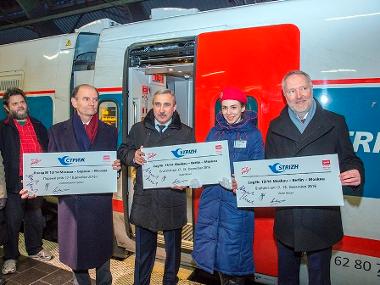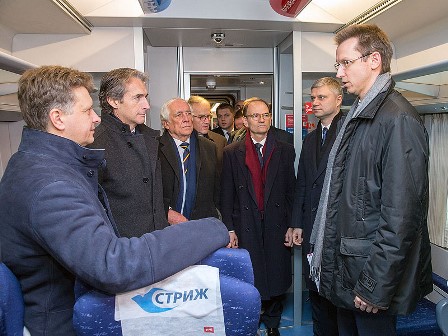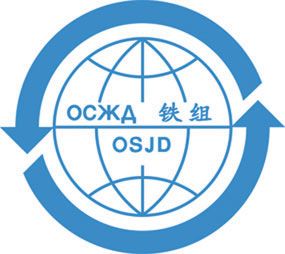The “Strizh” train has made its maiden trip from Moscow to Berlin



On this day the Kursk station hosted a solemn ceremony devoted to the departure of the first train which was attended by the delegations of the Ministry of Transport of the Russian Federation headed by the Minister of Transport Maxim Sokolov, Ministry of Development of the Kingdom of Spain headed by Minister Inigo de la Serna, Embassies of the Kingdom of Spain, the Republic of Poland, Republic of Belarus, Russian Railways JSC headed by President of the company Oleg Belozyorov, FPC JSC headed by its General Director Pyotr Ivanov, PKP InterCity JSC headed by Chairman of the Board Marek Chraniuk, the Spanish company “Patentes Talgo S.L.” headed by its President Carlos Maria de Palasio i Oriol, Byelorussian Railway, as well as numerous representatives of mass media and other officials and guests.
The train was solemnly met on its way in the capitals of the states through which the route passed:
- in Minsk (Republic of Belarus) – by the delegation of the Byelorussian Railway headed by the Chief of Passenger Service Alexander Zakharevich;
- in Warsaw (Republic of Poland) – by the delegations of the Embassy, General Consulate and the Trade Representation of the Russian Federation in the Republic of Poland headed by the Head of the Consular Department of RF in RP Vladimir Efremov and the Trade Representative of RF in RP Vladimir Nefyodov, of the PKP InterCity JSC headed by the Chairman of the Board Marek Chraniuk, of the OSJD Committee headed by Deputy Chairman of the Committee Victor Zhukov;
- at the destination station of Berlin (Federal Republic of Germany) – by the representatives of the German Railway JSC (Deutsche Bahn AG).
Addressing the public the participants of those ceremonies underlined the importance of opening of a new route with the use of the innovative technologies allowing to improve considerably the service quality for passengers, to reduce en-route time thus having increased the efficiency and competitiveness of the international railway service in relation to other transport modes, especially aviation.
The “Strizh” train is composed by the coaches of the Federal Passenger Company JSC (FPC JSC) which is a subsidiary of the Russian Railways JSC and possesses the status of an OSJD observer.
For the first time the passenger train is composed by the coaches equipped with an automatic gauge control system. It allows to reduce time required to change from the 1520-mm track gauge to the 1435-mm track gauge at the station of Brest on the Belarusian-Polish border. The train needs about 20 minutes to pass through the specially built automatic gauge changing device whereas the technological time required to change the bogies in the coaches of other Russian trains takes about 2 hours for a train.
Thus, the distance from Moscow to Berlin is covered by the “Strizh” train in 20 hours 14 minutes (for comparison – the travel time along the similar route of another train of the FPC JSC No. 23 Moscow – Paris takes 24 hours 49 minutes), and from Berlin to Moscow – in 20 hours 35 minutes (train No. 24 Paris – Moscow – 25 hours 56 minutes).
The coaches of the “Strizh” train have been produced by the company “Patentes Talgo S.L.” (Spain). The similar Talgo trains have been in operation on other railways of the 1520-mm space in such OSJD member countries as Kazakhstan, Russia and Uzbekistan, with the only difference that they run only in domestic service without changing the track gauge on the borders.
The train will run 2 times a week, departing from the Kurskaya station of Moscow on Saturdays and Sundays at 13:05 and arriving in Berlin (station Ostbahnhof) at 07:19 the next days (local time). From Berlin (station Berlin Ostbahnhof) the train will depart on Sundays and Mondays at 18:50 (local time) and arrive at the Kurskaya station in Moscow at 17:25.
Along the route line the train stops at stations Smolensk, Orsha, Minsk, Brest, Terespol, Warsaw, Poznan, Rzepin, Frankfurt (Oder). Each train is composed of 20 coaches:
- 5 sleepers of the second class (4 four-seater compartments and 1 double-seater compartment – totally 18 places in the coach);
- 4 coaches of the first class (6 double-seater compartments – 12 places);
- 3 coaches of the first class (2 double VIP-compartments equipped with a shower and a bathroom, and a compartment of the second class for the disabled persons accompanied by their attendants – totally 6 places per coach);
- 2 coaches of the VIP-class (5 double VIP-compartments equipped with a shower and a bathroom – 10 places);
- 2 coaches with sitting places of the first class (20 places in each coach);
- on-board bistro;
- on-board restaurant (dining-car).
The train is also provided with the technical coaches (in the front and in the back part of the train) which support the functioning of its life-support systems.
Patentes Talgo S.L.
On 18 June 2011 within the framework of St. Petersburg International Economic Forum the FPC JSC and the Spanish company “Patentes Talgo S.L.” signed an agreement for the development and delivery of passenger trains. According to the agreement, the company “Patentes Talgo S.L.” has delivered to the FPC JSC 7 twenty-unit trains. The first group of 4 trains was received in 2014-2015 (including the coaches with sitting places of the 1st and 2nd class, VIP coaches, on-board restaurant and on-board bistro and has been in operation on the Moscow – Nizhny Novgorod route since 1 June 2015 (train "Strizh"); 3 trains equipped automatic gauge control system were delivered in 2016 and jhave been running since 17 December 2016 along the route Moscow – Berlin – Moscow.
The agreement signed with the company “Patentes Talgo S.L.”, provides also for rendering full-scale maintenance services and repair of railway vehicles. The Talgo rolling stock has undergone all necessary certification tests in Russia, Poland and Germany.
The company “Patentes Talgo S.L.” was chosen as a supplier of railway vehicles because of its wide experience in construction of the trains capable of transferring from one track gauge on to aanother of different standards. The system appeared as far back as in the 1970s of the last century and was developed in order to provide a direct railway service from Spain to France and Switzerland, despite the different track gauge. By means of this system it is possible to change the gauge width of the wheel sets so that the passengers could stay in the train which without being stopped could change from one track to another, without wasting a lot of time for the bogies to be replaced.
In coordination with the Byelorussian side an automatic gauge-changing device of Patentes Talgo production was designed and built up in the city of Brest for the transfer of the trains between the track gauges of 1520 and 1435 mm wide: a concrete basement for the installation of the transfer device and the automatic gauge-changing device itself have been assembled, the gas heating, water supply and sewerage have been arranged, a hangar of 70 meters long has been erected over the transfer device.
The main technological features of the Talgo trains running between Moscow and Berlin are as follows:
- automatic gauge-changing system for the transfer between the track gauges of 1520 and 1435 mm wide;
- body tilting system that provides for the decrease in en-route time thanks to the higher speed of passing the curves of small radius;
- design speed – 200 km/h;
- operation at outside temperatures from -40 ° to +40 °C;
- length of the multiple unit – 263 m (between buffers), the train weight – 378 tons;
- easy design;
- jointed type of coaches;
- controlled axles;
- independent wheels;
- low center of gravity;
- high level of safety;
- lowered level of wearing out of rails and wheels;
- lower infrastructure maintenance costs.
Advantages for the passengers:
- on-board en-route information system: internal and external panels;
- GPS-positioning system;
- automatic internal doors to isolate passengers from the noise sources;
- seats and equipment for the transportation of the disabled persons, to include those cecutients and deaf-and-dumps;
- the floor level at the same height, without slopes.
OSJD focuses particular attention onto the activities aimed at ensuring technical interoperability between the systems of different track gauges – 1435 and 1520 mm. In this regard continuous work has been performed by the OSJD Commission on Transport Policy and Development Strategy in cooperation with the Railway Agency of the European Union, whereas within the framework of the OSJD Commission on Infrastructure and Rolling Stock as a result of work of the Ad Hoc Working Group on the Automatic Gauge Control Systems (AGCS) a recommendatory leaflet has been developed which concerns the application of those systems on the railways of the OSJD member countries.
